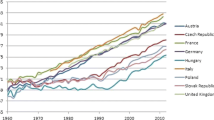Abstract
This article analyses how long-run pay-as-you-go public pensions react to a change in fertility in the Diamond overlapping generations model. While it might seem well established both in academic and political debates that the decline in fertility represents a “demographic time bomb” for the sustainability of public pensions, it is shown that a falling birth rate need not necessarily cause the fall of pensions in the long run.
Similar content being viewed by others
Notes
“That children impose economic costs on their parents seems to be widely accepted.” (Deaton and Muellbauer, 1986, pp. 720–721).
The current average contribution rate is estimated to be around 0.16 in Europe and 0.11 in the USA (see, e.g., Liikanen 2007, p. 4).
For instance, Deaton and Muellbauer (1986, p. 720) found that “Sri Lankan and Indonesian data suggest that children cost their parents about 30–40% of what they spend on themselves,” while also arguing that such estimates “would not be appropriate for developed countries where children bring heavy non-food expenditures.” (p. 741) Therefore, q ≅ 0.3 is reasonable for developed economies.
References
Boeri T, Börsch-Supan A, Tabellini G (2001) Would you like to shrink the welfare state? A survey of European citizens. Econ Pol 16(32):7–50
Boldrin M, Jones LE (2002) Mortality, fertility, and saving in a Malthusian economy. Rev Econ Dynam 5(4):775–814
Bovenberg AL (2007) Grey new world: Europe on the road to gerontocracy? In: Europe and the demographic challenge. CESifo Forum 8(3):7–11
Burbidge JB (1983) Social security and savings plans in overlapping generations models. J Public Econ 21(1):79–92
Cigno A (2007) Low fertility in Europe: is the pension system the victim or the culprit? In: Europe and the demographic challenge. CESifo Forum 8(3):37–41
Deaton AS, Muellbauer J (1986) On measuring child costs: with applications to poor countries. J Polit Econ 94(4):720–744
Diamond P (1965) National debt in a neoclassical growth model. Am Econ Rev 55(5):1126–1150
Fanti L, Gori L (2010) Increasing PAYG pension benefits and reducing contribution rates. Econ Lett 107(2):81–84
Fenge R, von Weizsäcker J (2010) Mixing Bismarck and child pension systems: an optimum taxation approach. J Popul Econ 23(2):805–823
Liikanen E (2007) Population ageing, pension savings and the financial markets. Bank Int Settlements Rev 53:1–6
Sinn HW (2007) Introduction to: Europe and the demographic challenge. CESifo Forum 8(3):7–11
van Groezen B, Leers T, Meijdam L (2003) Social security and endogenous fertility: pensions and child allowances as Siamese twins. J Public Econ 87(2):233–251
Wigger BU (1999) Pay-as-you-go financed public pensions in a model of endogenous growth and fertility. J Popul Econ 12(4):625–640
Acknowledgements
We gratefully acknowledge the editor Prof. Alessandro Cigno and two anonymous referees for valuable comments on an earlier draft. Usual disclaimers apply.
Author information
Authors and Affiliations
Corresponding author
Additional information
Responsible editor: Alessandro Cigno
Rights and permissions
About this article
Cite this article
Fanti, L., Gori, L. Fertility and PAYG pensions in the overlapping generations model. J Popul Econ 25, 955–961 (2012). https://doi.org/10.1007/s00148-011-0359-7
Received:
Accepted:
Published:
Issue Date:
DOI: https://doi.org/10.1007/s00148-011-0359-7




